7/20/2021
Review of Game & Watch Gallery 4
Developed by: Tose
2002, Game Boy Advance
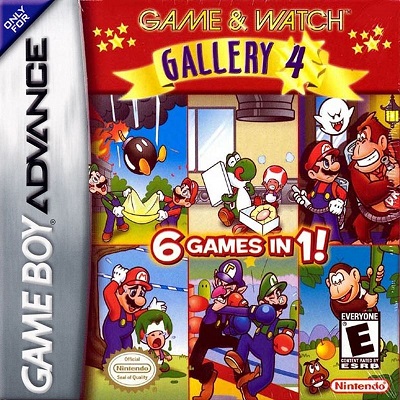
The Game & Watch series of games are so simple, it almost feels wrong to like some of them as much as I do. I'd rather play some of these than most 80's arcade games I've seen. My favorite game in Game & Watch Gallery 4 is "Fire". "Fire" was originally released in 1981, the same year as Donkey Kong, and I'd rather play "Fire" than Donkey Kong. I'd rather play the Game & Watch version of Donkey Kong Jr. that's included in this collection than play the original Donkey Kong Jr. Maybe it's because the movement in a Game & Watch is so restrained, it can't feel as sluggish as many other old games do. Maybe it's because each game focuses on a simple, repeated action that the game designers at least had to try making it a good one. Maybe I'll find out as I write about each game below.
I've wondered if there's something fundamentally bad about these games because they're simple. I wondered if I'd play any of these on a phone in my free time. Then I thought about Canabalt (-8-), the side-scrolling running and jumping game that could be reduced to two buttons. If it was a Game & Watch game, you would have a button to do a short hop and the other button to do a long jump. It would be about timing your jumps to reach platforms of different heights, and as you played, the platforms would scroll by faster and you would clear more of them per jump to simulate increasing speed. Of course many great things about Canabalt would be missing, including the jumps feeling physically fun, but I think it could work because of the original game's simplicity. Canabalt isn't considered to be too simple, it's considered to be good in part because of it's simplicity, and I think the same applies for some of these Game & Watch titles.
As a collection, Game & Watch Gallery 4 has more games I don't really care about than not. But with every new game, it was interesting to see what they could come up with in the limitations of a Game & Watch. There are only a few verbs you can use throughout and most of the challenges are based around the same ideas, but they're handled differently enough.
FIRE, Modern -7.5-
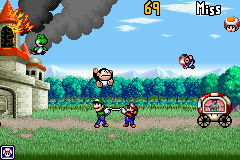
You catch characters falling from a burning building. There are three positions where a character can fall, and you have to be in that spot as they reach the ground so you can bounce them further to the right. The "Modern" version changes the fall speed depending on the type of character. Once there are many characters falling on screen at once, you need to quickly discern the order the next couple of them will hit the ground. Your brain then makes a multi-step plan of the next four or five spots to be in within the next few seconds. It has a great, puzzle-like feeling.
I can imagine an even more modern version of this that I think would be great. Instead of moving in just three spots, you could run and jump and hit the falling characters with inertia-filled action. The characters would pinball off each other and you could use them to keep others in the air. The characters would still fall in an easily discernible way so it would have the same action-puzzle feel.
FIRE, Classic -7.5-
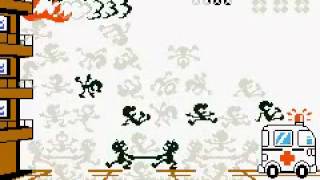
The classic version of "Fire" is my favorite game in this collection. It works the same as the modern version, except the characters all fall at the same speed and they don't move smoothly, because it has the original LCD graphics. The choppy animation makes it easier to tell who's going to hit the ground first.
It feels great when the screen is filled with Game & Watch guys and you're bouncing one on every beat. It starts to feel like a rythm game because you hear a metronome-like ticking sound every time a character moves, with a different click every time you bounce someone, and those ticks and clicks start to feel like a beat that you're playing along with.
BOXING, Modern and Classic -5-
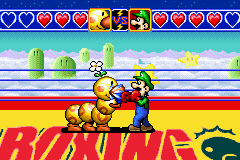
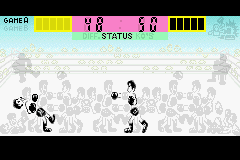
Both versions are the same as far as I care to know. This is the only game where I figured out how to win indefinitely, and that was on the 2nd time playing it. The game is about seeing whether they're blocking up or down and reacting fast enough. It has multiplayer. If you were playing against a person, you wouldn't always know which way to attack, like you do against the computer, and maybe it wouldn't be miserable.
RAIN SHOWER, Classic -7-
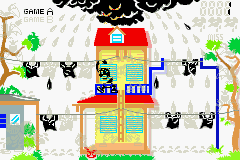
"Rain Shower" is similar to other Game & Watch titles, such as "Fire", that are about juggling. Juggling seems to be what a Game & Watch does best. Fittingly the first Game & Watch was called "Ball" and was about literal juggling.
In "Rain Shower", you can move four clotheslines to avoid the rain falling from the top of the screen. It's like a juggling game, but there's a delay from when you see the raindrop to when it passes the piece of clothing that you want it to avoid five seconds later. It makes you pay attention to the whole screen instead of just which raindrop is falling first. I like the crows that occasionally come down from their trees to move one of the clotheslines, because it adds one more thing to pay attention to. Although I didn't figure out their timing and it felt too random when a crow was about to move a line just as a raindrop was one space away.
Unfortunately the game is one of the slowest in the collection and there are many moments of sitting in boredom per game.
RAIN SHOWER, Modern -6.5-
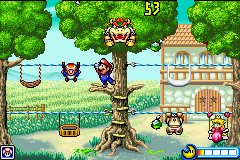
A new problem is introduced in the modern version because it isn't simulating an LCD screen. Unlike the classic version, you can't immediately tell which lane the raindrop is falling in. They changed the raindrops to water balloons and gave each of them a different color depending on where they will fall, I guess to fix that, but you end up having to memorize which colors go where on each side to have a better chance.
MARIO'S CEMENT FACTORY, Modern -6-
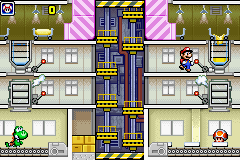
"Rain Shower" was one of the slowest games in this collection, second only to "Mario's Cement Factory". The carts, which appear at the top of the screen and drop cement into the containers that you then funnel down to be made into pastries, are too seldom. I think that's necessary for you to have time to move around the level (part of the game is about waiting for elevators after all) but the action is so spaced out that you're doing nothing 25% of the time. It ends up taking much longer to get a high score in this game compared to others.
Moving around in the game is the only redeeming part. There are four stations where you can pull a lever and dump the cement down to the next level. You take elevators in the center of the screen to get to these places, but they each work a little differently. Some stations are harder or easier to get to, and it gives them different priorities.
The most difficult station to reach is in the top-left. The only way to get there is to be at the top-right side and wait for two elevators to line up so you can cross. It takes the most time to get there, so even if you only have two loads in the top-left container and another one is full, it still might be better to empty the top-left first. If you're already at the top-left spot, then it's easiest to get to the bottom-left, because the elevators on that side go down and you can quickly jump there. If you're on the top-right side, you can quickly get to the bottom-right in the same way, but because the elevators are going up on that side you need to quickly squeeze between them to get to the lower level.
The asymmetry of the four positions makes figuring out what order to drop the cement less clear and more interesting. In "Fire" for example, you always know who you should bounce first as long as you can keep up. In "Cement Factory" the same decision is layered under multiple factors and tied up with your ability to execute moving around the level quickly.
MARIO'S CEMENT FACTORY, Modern -5-
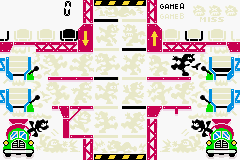
Unlike the modern version of "Mario's Cement Factory", in the classic version you can't fall from any height. If you don't step on the elevator exactly when it lines up you'll miss it and lose a life. At least for me, this happens all of the time and it adds frequent annoyance to an already tedious game.
DONKEY KONG JR., Classic -7-
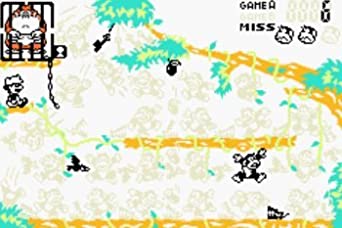
If games such as "Fire" are about juggling, "Donkey Kong Jr." is about timing. You have to avoid the crocodiles on the ground and the birds in the air. They both move at a different beat, so there's only a small window when you jump that you won't get hit. When there are a lot of them on screen it feels like you're weaving around the level on every click forward of the game.
Also, your character can move as fast as you can press the button, so you can cross multiple spaces before the enemies move. It's always fun to try and make it from the bottom of the screen to a safe vine at the top of the screen in between one move of the crocodiles.
There's only one level in this game and I like that it has idiosyncrasies. There are vines, which make it easier to avoid the crocodiles, in some spots on the bottom half of the screen but not in others. When you climb the vines to get to the top half, the crocodiles will jump over and avoid you if you're hanging in the right spot. At the end of the level you need to jump and grab a key before you start it over. You need to time the jump when the key is on the one right frame, otherwise you'll fall to the bottom and lose a life. I like that there's a dramatic-feeling moment at the end that's different from the rest of the level, even if it's repeated over and over again.
DONKEY KONG JR., Modern -7-
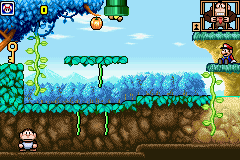
The modern version feels almost like a typical action game. In the early stages you can reach the end of the level in only a few seconds, if you're able to move your character fast enough. It feels freeing compared to the other games in the collection where your speed's determined by the pace of the game. It still has a puzzle kind of feeling to it because you can't just use skill to get around the enemies once they're in your way.
DONKEY KONG 3, Modern and Classic -6-
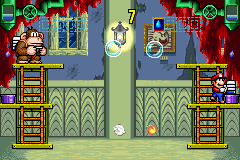
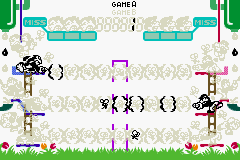
I spent most of these games in something like a stalemate, pushing the things in the center of the screen back and forth. I don't think these games are completely bad only because it feels like there could be some strategy to it. If you shoot your bubbles/pesticides in the right order, you might be able to get multiple hits in a row. If you were playing against another person, trying to do that while factoring in where your opponent is shooting might make it feel like the world's simplest MOBA.
Games I was able to unlock:
CHEF, Modern -7.5-
Similar to "Fire" except you can flip your character as well as move left and right. The falling food is also less predictable. There's actually a little strategy involved, which is rare for these games. You can choose to keep bouncing the food in order to cook it longer and get more points, which makes it more difficult because you have more food in the air, or you can feed it to Yoshi so there's less food to deal with.
CHEF, Classic -6.5-
Pretty much missing anything that's interesting in the modern version.
MARIO BROS., Modern and Classic -7.5-
My favorite of these unlockable games. As the cakes are rolling down the conveyor belts, you need to determine which ones will reach the edge first and plan out where you'll be in the next couple steps, and since you're controlling two characters, you need to do this separately on each side of the screen.
Are games where you control two different characters simultaneously inherently interesting? Cookie and Cream, Ranger X and his pet motorcycle, Libble and Rabble...
DONKEY KONG, Modern -7-
It feels similar to the modern version of "Donkey Kong Jr.", but slower because you have to wait for obstacles to pass by more often. I never figured out how the clouds on the last level work, but if they disappear randomly then that's terrible and this game is actually much worse.
DONKEY KONG, Classic -5-
The worst game in this collection. You have to constantly wait for barrels to pass by, and there are a lot of areas where you can't jump because there's something over your head, so you have to go backwards to avoid the barrels which makes the level take even longer.
OCTOPUS, Modern and Classic -6.5-
More than timing, this one's about keeping an eye on all of the octopus's tentacles at once. Each tentacle extends randomly, so it's hard to know where you should go next at any point. This makes "Octopus" different among the games where things are falling from the sky and there's a clear order to everything.
I think the best strategy is to retreat away from the treasure frequently, because it's easier to avoid the tentacles further back. The problem is playing the game the right way makes you play much slower. On one side, this might be the game's reflection of your own greed, on the other I think it's testing your patience/ability to not die out of boredom.
For all being simple games, it's funny I like some of them a lot more than others. One small issue seems bigger if the game is only made up of a few parts. Since they all look similar and are of a similar scope, you'd think they'd be equally as fun, but the differences in the fundamental gameplay are amplified when they're repeated over and over.